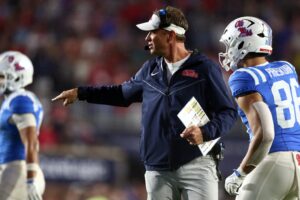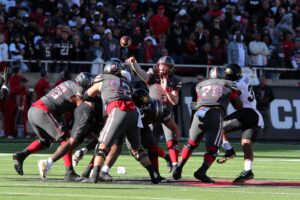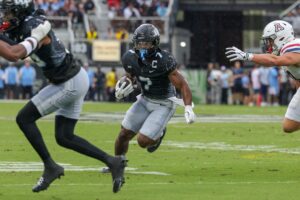Rome was not built in a day. As it turns out, neither are sustainably successful college football programs. Look at Kansas State, for example. Kansas State was a perennial cellar dweller prior to Head Coach Bill Snyder’s arrival. In the 20 seasons predating Snyder, Kansas State had as many zero- or one-win seasons (five) as it did seasons with five or more wins. Yet, as successful as Snyder was, it still took him seven years to produce his first ten-win season. Fans should keep this in mind as we ask in this final part of our three-part series, just how high will the Mountaineers climb under Head Coach Dana Holgorsen.
Part One covers the modern era of West Virginia football through the departure of Coach Rodriguez. Part Two covers the Coach Stewart Era and the first couple of years of the Dana Holgorsen Era.
Growing Pains
2013 Season
Over the next three seasons, Mountaineer fans “suffered” through continued disappointment. In 2013, West Virginia managed only four wins as its defense went through additional struggles and the offense sputtered, finishing 79th in the nation in points per game. As a testament to the lack of depth Holgorsen inherited, the third-year coach relied on career backup Paul Millard, Florida State transfer Clint Trickett, and disappointing recruit Ford Childress to lead the offense. Trickett appeared the most polished of the bunch, but it was also his first year in Holgorsen’s system. Predictably, West Virginia’s offense had trouble moving the ball.
2014 Season
In the offseason, Holgorsen hired Tony Gibson to run his defense. Gibson promptly reinstalled the 3-3 stack that Rodriguez’s teams employed so effectively. Holgorsen took a far more active role in the development of his offense. And Trickett improved dramatically.
With a year under his belt, and the addition of woefully underrated Kevin White, Trickett looked the part of a veteran quarterback. In the season opener, he threw for 365 yards and a touchdown against a stout Alabama defense. West Virginia lost 33-23. But they fought valiantly, and a couple of dropped passes and a phantom penalty on the sideline were the differences between the loss and an upset win.
The Mountaineers gained momentum in October, winning four straight, including a victory over fourth-ranked Baylor in Morgantown, the second “signature” win of the Holgorsen era. A couple of games later, the Mountaineers held a 27-14 lead against tenth-ranked TCU midway into the third quarter. Then, the wheels fell off. The staff called plays to hold the lead rather than to extend it. TCU took advantage. And the Mountaineers lost the game 31-30 on a last-second field goal.
The Mountaineers looked ready to rebound against Kansas State. Trickett suffered a career-ending concussion in the game, but a feisty Skyler Howard led a gutsy second-half comeback attempt that fell just short. A couple of simple mistakes again made the difference between a win and a loss.
The 2014 Mountaineers finished 7-6. Unfortunately, to casual fans, the youth and inexperience of the coaching staff likely cost the team two wins that season. However, the promise of Holgorsen started to shine. Seventeen points stood between 7-6 and 10-3, this against a schedule that featured four top-ten teams and another top fifteen opponent.
2015 Season
The Mountaineers started the 2015 season 3-0 after decisive victories against Georgia Southern, Liberty, and Maryland. The defense looked vastly improved. Howard looked like he had much better command of the offense. Then, October happened. The Mountaineers faced a gauntlet that month, visiting 15th ranked Oklahoma and top five Baylor and TCU. They also faced Oklahoma State, which was ranked 21st, in Morgantown.
The loss to Oklahoma State was particularly hard to accept. Again, the team made just a handful of critical first-half mistakes, including a few penalties on special teams that negated big-time returns from Shelton Gibson and a botched exchange on a snap in the red zone. The resulting field position flips stalled the offense on a couple of first-half drives, and West Virginia went into halftime down 17-2. Behind Howard, the offense came out of the locker room firing and tied the game with 2:44 left. The first-half mistakes, however, would haunt the Mountaineers as they surrendered a score in the first overtime and lost 33-26.
Ultimately, the Mountaineers went 0-4 in October. But they won four straight in November and looked to end the regular season with a win (Holgorsen’s first) against Snyder’s Kansas State team. The result? Another single-point loss that can be pinned on just a couple of plays late in the game.
The Mountaineers did end the season on a high note, however. West Virginia won a shootout against Arizona State in the Cactus Bowl. Things looked promising. The Mountaineers were again just a few points (eight, to be exact) from a ten-win season. The defense under Gibson had improved dramatically in just two years (from the 100th scoring defense in 2013 to the 48th in 2015). And the offense was returning most of its big pieces for the 2016 season.
Righting the Ship
2016 Season
The Mountaineers started the 2016 season with six straight wins for the first time since 2012. They ended the season at 10-3, ranked 18th in the nation. The defense continued its improvement under Gibson, finishing the season 35th in the scoring defense despite losing nearly two-thirds of its production from 2015. And the team finished well despite an unanticipated offensive regression.
Through his sixth season, Holgorsen boasted two separate ten-win seasons (out of the nine such years West Virginia has had in its entire history). In short, Holgorsen’s teams were hitting ten wins 33% of the time. Only 21 schools over the past 20 seasons can say they hit ten wins at a rate as good (or better) than Holgorsen’s. In fact, only 22% of any team’s seasons, on average, hit the ten-win plateau. During that time, Holgorsen also won 11 more games than was predicted by composite recruiting rankings, meaning he got more out of his talent than was expected.
2017 Season
In the meantime, Holgorsen was silently adapting his recruiting profile by adding top-flight talent through the transfer market. Not only did Holgorsen add junior-college talent, but he also added crucial talent from Power Five schools. Holgorsen’s new-found recruiting prowess was covered in-depth here. Suffice it to say, Holgorsen brought in critical pieces of the “puzzle” through these means.
Only one of these names would join the list of eligible players for the 2017 season: Will Grier. Because he had a year to learn the system, fans and analysts expected an immediate impact on offense. But Gibson again replaced nearly two-thirds of his prior-year production. As a result, expectations ranged from five to eight wins.
Unfortunately for the offense, the Mountaineers lost two key pieces for the opener against Virginia Tech. Jovon Durante transferred to Florida Atlantic after fall camp began, and Marcus Simms faced a one-game suspension. West Virginia felt those losses acutely. Simms’ return-game prowess cost the Mountaineers field position the entire game. The lack of bench depth at the position put noticeable wear on the receivers through the second half.
Absent those unexpected losses, West Virginia likely could have opened the season with a win. Without the time to adapt, however, the Mountaineers opened 0-1 with a single-score loss. West Virginia fought back and held a 7-3 record going into its game against Texas in Morgantown. As fans no doubt recall, Grier broke a finger on his throwing hand diving for the end zone in the first quarter. This ended his season.
Without a trustworthy backup, the offense fizzled, and they ended the year 7-6, still within the higher end of pre-season expectations. While the season disappointed, many understood that the Mountaineers were again just two bad breaks away from another ten-win year.
How High Will the Mountaineers Climb
Current Season
Expectations for the Mountaineers’ 2018 season diverged. On the one hand, some thought the Mountaineers were a dark-horse contender for the college football playoff. Others thought the Mountaineers would field a woeful enough defense to struggle for six or seven wins. (For the record, we predicted here that the Mountaineers would field a top-30 defense thanks, in part, to Holgorsen’s transfer market maneuvers. We also predicted here that Grier would weather a Heisman campaign. He is still in the race, albeit with a closing window.)
The season is young, but the Mountaineers have exceeded early expectations. They left Lubbock with a top-25 conference win. They have escaped the injury bug, depth issues, and undisciplined mistakes mostly unscathed. As recent history proves, West Virginia cannot usually say the same. Injuries and mistakes have cost the Mountaineers at least 10 wins over the last five seasons.
Instead, the Mountaineers are 5-1 and ranked 13th at the halfway point. And the Mountaineers have talent at every position and the players themselves seem to believe they can win big. They continue to post impressive numbers, even with a few hiccups along the way. And no doubt future transfers are certainly watching what Holgorsen and company are doing with its current crop. The higher the Mountaineers climb this season the higher they can ascend in the future.
The Future
No matter how well the Mountaineers perform this season, though, there is reason for optimism in coming years. The Mountaineers have built a solid recruiting class. They continue to add transfer talent, including a highly-rated linebacker from Alabama. And they have replacements at every position going into next season.
Through his recruiting efforts to date, Holgorsen finally has what eluded him since he arrived in Morgantown. He has the depth to sustain multiple years of success. He has two highly-rated quarterbacks and a balanced rotation at the skill positions. And he has defensive depth.
Holgorsen has also built quite the sales pitch. His guys are playing more and more like a team. As discussed here, they celebrate each other (and do so in style). He is building a family in Morgantown. And Holgorsen sure has grown to love the State of West Virginia, too.
Holgorsen can also sell his talent development. He is an upper tier coach in this regard. He finds diamonds in the rough and molds them into draft picks. And, he takes talent expected to be drafted and helps those players meet and exceed expectations.
Holgorsen is quickly developing a winning culture as he matures as a head coach. Simply, he does the things you want to see as a fan, player, and booster. He excites the fan base. He develops and mentors his players. And he wins more than he “should” (which is well above average). It seems like he is doing just fine building Rome in Morgantown, even if that did not happen in a day.






